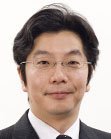MURAYAMA Hideaki
(Professor/Division of Environmental Studies)
Department of Ocean Technology, Policy, and Environment/Integrated Marine-System Health Management

Career Summary
Associate Professor in the Department of Systems Innovation, School of Engineering, University of Tokyo (April 2008 - May 2017).
Visiting Researcher at KTH Royal Institute of Technology (April 2015 - April 2016).
Associate Professor in the Department of Environmental and Ocean Engineering, School of Engineering, University of Tokyo (October 2006 - March 2008).
Lecturer in the Department of Environmental and Ocean Engineering, School of Engineering, University of Tokyo (May 2003 - October 2006).
Researcher at the National Space Development Agency of Japan (NASDA)* (March 2001 - May 2003).
Research Fellow of Japan Society for the Promotion of Science (JSPS) (January 1999 - March 2001).
* On October 1, 2003, ISAS, NAL, and NASDA were merged into one independent administrative institution: the Japan Aerospace Exploration Agency (JAXA).
Educational Activities
Graduate school:
Graduate School of Engineering: System Reliability Engineering, Ocean Engineering, Project-Based Learning in Vehicle Engineering
Undergraduate: Strength of Materials, Advanced Design, Project-Based Learning in Sensing Technologies
Research Activities
Goal of my research
Development of a material/structural system that enables vehicles, robots, and infrastructures to work efficiently and reliably in ocean space. Advanced composites and sensing technologies based on “fibers” such as carbon fiber and optical fiber are key.
I classify my research as follows:
a) Study on Structural Health Monitoring and Management (1995 - present)
My aim is to create a structure that can monitor its own condition and integrity and then call for suitable operation or maintenance works. This kind of structure needs nerves and a brain to identify the condition and make the right decision the same as a human being would do. To give senses and perception to the structure, I am mainly investigating fiber-optic sensing technology and developing a fiber sensor network system. I am also developing analysis methodologies to reconstruct the overall strain distribution, temperature distribution, deformation, and load based on measured information obtained from limited locations. The purpose of this study is to improve the efficiency, reliability, and safety of offshore structures, ships, space transportation systems, aircraft, civil structures, and so on.
b) Development of Distributed Fiber Optic Sensors (2002 - present)
I have developed a fiber-optic distributed sensing system with high spatial resolution (less than 1 mm) that can easily map the strain and temperature profile along the sensing fiber with fiber Bragg gratings (FBG). This sensing system based on optical frequency domain reflectometry (OFDR) can be applied to precise and global strain and temperature measurements in various structures. Now I'm aiming to increase the performance of the sensing system in terms of the measurement speed, measurement range, and simultaneous measurement technique in order to enhance its applicability.
c) Marine Composite Structures (2007 - present)
Composite materials have an advantage in the marine field thanks to their higher specific strength/stiffness and corrosion resistance. Composites have generally been used as material for the hulls of boats. I'm aiming to enhance the performance and environment adaptability of vehicles and offshore structures by applying composites to them. To this end, I developed technologies for the passive pitch control blades of an ocean current/tidal power generation system in a project between 2007 and 2011. Marine composite propellers have also been developed for merchant vessels in other project with companies from 2007 onward. In this project, I'm aiming to develop technologies to enhance the strength of composites for marine propellers and to design a higher performance propulsion system.
d) Ocean Drones (2017 - present)
As part of various pedagogical projects at the university, I have developed autonomous surface vehicles (ASV) and micro aerial vehicles (MAV) with students since 2003. It is assumed that a renewable energy-powered vehicle with a structural health management system and a composite lightweight structure will be able to fulfill consecutive and long-term missions in the harsh ocean environment. In addition, collaborative operation with UAV/MAV, ASV, and ROV/AUV enables us to acquire deeper understanding and discover the mechanisms behind various phenomena in ocean space.
Literature
1) Murayama, H., Structural Health Monitoring of Composite Materials Using Distributed Fiber-Optic Sensors, in Structural Health Monitoring of Composite Structures Using Fiber Optic Methods, CRC Press, pp. 105-156 (2016).
2) Ogawa, D., Murayama, H., Kageyama, K., Kanai, M., Yamatogi, T., and Sakurai, T., Evaluation of bending fatigue characteristics of CFRP for marine propellers, 20th International Conference on Composite Materials, Copenhagen, 19-24th July 2015.
Other Activities
The Japanese Society for Naval Architects and Ocean Engineers
Japan Society for Composite Materials
The Japanese Society of Mechanical Engineers
Japan Society of Civil Engineers
Japan Society of Maintenology
Future Plan
The final goal is the social implementation of technologies to make people happy and comfortable. The development of fundamental and innovative technologies is also an important work for me.
Messages to Students
I hope you will join us to study more efficient and reliable vehicles/offshore structures, and through this study, to enjoy developing expertise and creativity.
